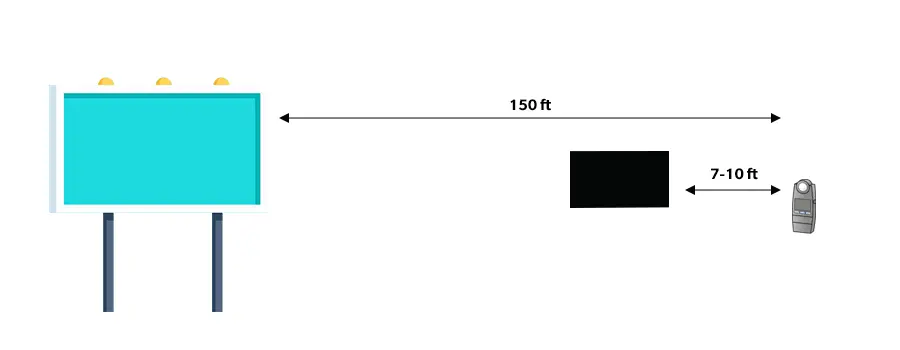การวัดความสว่างของป้ายโฆษณาดิจิทัลตามแนวทางของ OAAA

ป้ายโฆษณาดิจิทัลได้กลายมาเป็นส่วนสำคัญของวงการโฆษณาสมัยใหม่ โดยทำให้ทางหลวง ทัศนียภาพของเมือง และพื้นที่สาธารณะมีภาพที่สะดุดตา อย่างไรก็ตาม การมองเห็นที่มากของป้ายโฆษณายังนำมาซึ่งความรับผิดชอบที่สำคัญ โดยเฉพาะอย่างยิ่งในเรื่องระดับความสว่าง หากไม่ได้รับการจัดการอย่างเหมาะสม ความสว่างที่มากเกินไปอาจทำให้ผู้ขับขี่เสียสมาธิ มลพิษทางแสง เป็นต้น ดังนั้น องค์กรต่างๆ เช่น Outdoor Advertising Association of America (OAAA) จึงได้กำหนดแนวทางปฏิบัติและเทคนิคการวัดของอุตสาหกรรมเพื่อให้แน่ใจว่าป้ายโฆษณา LED มีประสิทธิภาพและไม่รบกวนสายตา
ตัวชี้วัดหลักสำหรับการวัดความสว่างของป้ายโฆษณาดิจิทัล
มีการใช้ตัวชี้วัดหลักสองประการในการวัดความสว่างของป้ายโฆษณาดิจิทัลโดยทั่วไป: นิต (Nits) และฟุตแคนเดิล (Foot-Candle) แม้ว่าทั้งสองจะเกี่ยวข้องกับแสง แต่ทั้งสองวัดด้านที่แตกต่างกันและมีวัตถุประสงค์ที่แตกต่างกันในบริบทของป้ายโฆษณาแบบดิจิทัล
นิต หรือที่เรียกอีกอย่างว่าความสว่าง เป็นหน่วยวัดความสว่างที่เปล่งออกมาจากจอภาพ โดยในทางเทคนิคแล้วจะกำหนดเป็นหนึ่งแคนเดลาต่อตารางเมตร (cd/m²) หน่วยเมตริกนี้มีความสำคัญในการทำความเข้าใจความสามารถด้านความสว่างของป้ายโฆษณาดิจิทัล รวมถึงความสดใสหรือความเข้มข้นของภาพที่ออกมา อย่างไรก็ตาม นิตเพียงอย่างเดียวไม่สามารถคำนวณถึงสภาพแวดล้อมโดยรอบได้ ในขณะที่ป้ายโฆษณาดิจิทัลอาจมีความสว่างโดยเนื้อแท้ แต่ความสว่างที่รับรู้ได้อาจแตกต่างกันอย่างมาก ขึ้นอยู่กับสภาพแสงโดยรอบ เช่น ที่ผู้ชมหรือผู้ขับขี่ต้องเผชิญ
ในทางกลับกัน ฟุตแคนเดิลวัดความสว่างหรือปริมาณแสงที่ตกกระทบพื้นผิว นี่คือแสงที่ตาของมนุษย์รับรู้ ทำให้เป็นการวัดที่ใช้งานได้จริงมากขึ้นสำหรับสภาพแวดล้อมจริง ฟุตแคนเดิลคำนึงถึงแสงโดยรอบ สภาพอากาศ เวลาของวัน และแหล่งกำเนิดแสงใกล้เคียงซึ่งนำเสนอภาพที่แม่นยำยิ่งขึ้นว่าป้ายโฆษณาดิจิทัลดูสว่างแค่ไหนต่อผู้ชมหรือผู้ขับขี่
OAAA แนะนำให้ใช้ฟุตแคนเดิลเป็นมาตรฐานในการวัดความสว่างของป้ายโฆษณาดิจิทัล ความต้องการนี้เกิดจากความต้องการสะท้อนถึงการรับรู้แสงในสภาพแวดล้อมจริง การวัดฟุตแคนเดิลโดยคำนึงถึงแสงโดยรอบช่วยให้ป้ายโฆษณามีความสว่างที่เหมาะสม ไม่มืดเกินไปในตอนกลางวันและไม่สว่างเกินไปในตอนกลางคืน นอกจากนี้ วิธีนี้ยังสอดคล้องกับประสบการณ์การรับชมจริงของผู้ขับขี่ โดยจับภาพว่าป้ายโฆษณาปรากฏอย่างไรผ่านกระจกหน้ารถท่ามกลางแหล่งกำเนิดแสงโดยรอบ ฟุตแคนเดิลไม่เพียงให้ลักษณะเฉพาะของความสว่างของป้ายโฆษณาได้ดีขึ้นเท่านั้น แต่ยังปลอดภัยและวัดจากระยะไกลได้ง่ายกว่าด้วย
การวัดความสว่างของป้ายโฆษณาดิจิทัลตามคำแนะนำของ OAAA
เพื่อให้แน่ใจว่าป้ายโฆษณาดิจิทัลจะไม่สว่างเกินไปสำหรับสภาพแวดล้อม จำเป็นต้องมีองค์ประกอบสำคัญสามประการดังนี้:
(1) ขีดจำกัดความสว่างสูงสุด (0.3 ฟุตแคนเดิล)
ระดับความสว่างสูงสุดที่แนะนำสำหรับป้ายโฆษณาดิจิทัลคือ 0.3 ฟุตแคนเดิล ซึ่งมาจากแนวทางของดร. เอียน เลวิน ตามมาตรฐานของสมาคมวิศวกรรมแสงสว่างแห่งอเมริกาเหนือ (IESNA) เพื่อลดการรบกวนแสงให้น้อยที่สุด ขีดจำกัดนี้ได้รับการออกแบบมาเพื่อลดแสงจ้าและป้องกันไม่ให้ผู้ขับขี่เสียสมาธิ ทำให้มั่นใจได้ว่าแสงสว่างจะปลอดภัยมากขึ้น
(2) เซ็นเซอร์วัดแสงโดยรอบ
แนะนำให้ติดตั้งเซ็นเซอร์วัดแสงโดยรอบ หรือที่เรียกอีกอย่างว่า โฟโตเซลล์ บนโครงสร้างป้ายโฆษณาเพื่อตรวจสอบสภาพแสงแบบเรียลไทม์ เซ็นเซอร์เหล่านี้จะวัดระดับแสงโดยรอบอย่างต่อเนื่อง โดยคำนึงถึงการเปลี่ยนแปลงที่เกิดจากสภาพอากาศ เวลาของวัน เป็นต้น
(3) ซอฟต์แวร์ลดแสง
ซอฟต์แวร์ลดแสงที่ทำหน้าที่ปรับความสว่างของป้ายโฆษณาตามค่าที่เซ็นเซอร์วัดได้ช่วยเสริมการทำงานของเซ็นเซอร์ ระบบนี้จะสร้างการเปลี่ยนแปลงที่ราบรื่นเมื่อสภาพแสงเปลี่ยนแปลงตลอดทั้งวัน ช่วยรักษาการมองเห็นที่เหมาะสมโดยไม่รบกวนผู้ชมหรือผู้ขับขี่
เพื่อการประเมินความสว่างที่มีประสิทธิภาพและสม่ำเสมอ OAAA กำหนดระยะทางมาตรฐานสำหรับการอ่านค่าฟุตแคนเดิลตามขนาดป้ายโฆษณา:
| ขนาดป้ายโฆษณา (ft.) | ระยะทางที่วัดได้ (ft.) |
| 12 x 24 | 150 |
| 10.6 x 36 | 200 |
| 14 x 48 | 250 |
| 20 x 60 | 350 |
การวัดควรทำในระยะห่างที่สอดคล้องกับขนาดของป้ายโฆษณา โดยให้เครื่องวัดแสงตั้งฉากกับด้านหน้าของป้ายโฆษณาโดยตรง ขั้นตอนการวัดทั่วไปเริ่มต้นด้วยการวัดแสงโดยรอบ โดยใช้แผ่นสีดำทึบแสงห่างจากเครื่องวัดแสงประมาณ 7 ถึง 10 ฟุต เพื่อกั้นแสงที่มาจากป้ายโฆษณา แล้วบันทึกค่าพื้นฐาน จากนั้นเพิ่ม 0.3 ฟุตแคนเดิลลงในค่าพื้นฐานนี้เพื่อคำนวณขีดจำกัดความสว่างสูงสุด นำแผ่นสีดำทึบแสงออก แล้วใช้เครื่องวัดแสงตรวจสอบความสว่างของป้ายโฆษณาอย่างต่อเนื่องเป็นเวลา 3 ถึง 5 นาที เพื่อตรวจสอบว่าความสว่างยังอยู่ในขีดจำกัดที่กำหนดไว้หรือไม่

ตัวอย่างประกอบการวัดความสว่างของป้ายโฆษณาเป็นฟุตแคนเดิล
เมื่อระยะทางมาตรฐานที่แนะนำเหล่านี้ไม่สามารถใช้งานได้จริง OAAA ยังจัดให้มีตารางการวัดระยะทางแบบสลับพร้อมแนวทางการปรับขีดจำกัดความสว่างสูงสุด–
โซลูชันการวัดแสงของ Konica Minolta สำหรับการวัดความสว่างของป้ายโฆษณาแบบดิจิทัล
เพื่อรองรับการจัดการความสว่างที่แม่นยำและเชื่อถือได้ของป้ายโฆษณาดิจิทัล Konica Minolta Sensing ซึ่งเป็นผู้นำที่เชื่อถือได้ในโซลูชันการวัดแสง มีเครื่องวัดแสงให้เลือกมากมาย เช่นเครื่องวัดความสว่าง T-10Aหรือโครมามิเตอร์ CL-200Aเป็นที่ไว้วางใจในอุตสาหกรรมโฆษณากลางแจ้ง เครื่องมือวัดแสงเหล่านี้ได้รับการออกแบบมาเพื่อช่วยผู้ควบคุมป้าย หน่วยงานกำกับดูแล หรือวิศวกร ทำให้สามารถวัดค่าความสว่างได้อย่างแม่นยำในหน่วยฟุตแคนเดิลหรือลักซ์ ทำให้มั่นใจได้ว่าเป็นไปตามมาตรฐานเช่นเดียวกับที่กำหนดโดย OAAA
สำหรับแอพพลิเคชั่นที่ต้องมีการอ่านค่าความสว่าง (nits) Konica Minolta Sensing ยังนำเสนอเครื่องวัดความสว่างประสิทธิภาพสูง เช่น Luminance MeterLS-150–LS-160และเครื่องวัดความสว่างและสีซีเอส-150–ซีเอส-160ซึ่งสามารถวัดค่าได้ในหน่วยแคนเดลาต่อตารางเมตร (cd/m2) หรือฟุต-แลมเบิร์ต (fL) นอกจากนี้ ฟังก์ชันการทำงานยังสามารถปรับปรุงได้ด้วยอะแดปเตอร์วัดความสว่าง ทำให้สามารถวัดความสว่างได้อย่างแม่นยำและใช้งานได้หลากหลายยิ่งขึ้น

จากซ้ายไปขวา: T-10A, CL-200A, LS-150 และ CS-150
หากสนใจที่จะทราบข้อมูลเพิ่มเติมเกี่ยวกับ Konica Minolta Sensingโซลูชันการวัดแสงหรืออาจต้องการความช่วยเหลือเกี่ยวกับวิธีการวัดแสงที่เหมาะสมสำหรับป้ายโฆษณาแบบดิจิทัลหรือการใช้งานจอแสดงผลภายนอกบ้าน สามารถติดต่อทีมผู้เชี่ยวชาญของเราี้เพื่อรับคำปรึกษาฟรีและเริ่มต้นใช้งานโซลูชันการวัดแสงที่เหมาะสมและเหมาะกับความต้องการของคุณ
